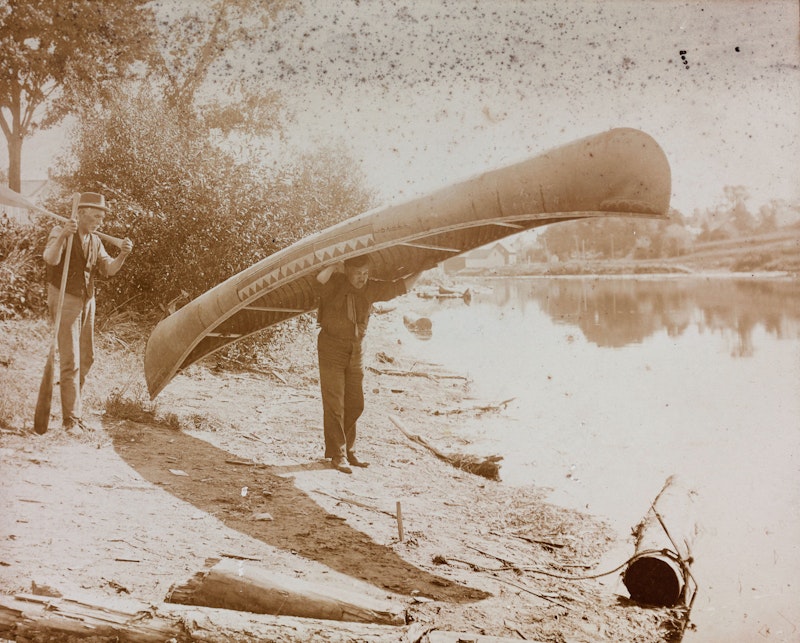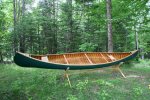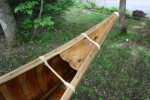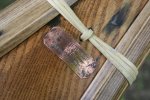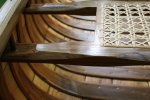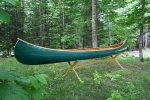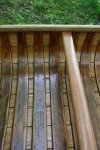Joseph Ranco's name as a canoe builder has been showing up in a number of posts here so I thought that it might be useful to consolidate what is known about him in one place and put out a call for any new information. His canoes often had heart shaped decks, spruce root or cane wrapped on the deck tips, removable bow seats, three closely spaced ribs at the end of the stems on each end, and a planking pattern that flared out to fill the turn of the bilge after the tenth rib (counting from each end). Many canoes from other builders in the Kennebunkport, Maine area also have these characteristics. Please respond here with pictures if you have a canoe with some of these features to see what we all can learn.
It appears that Joseph Ranco was born in April, 1865 based on census records and died in April, 1943 according to his obituary. I believe that his parents were Augustin Ranco (1813-1913) and Louisa Polis Ranco. Augustin seems to have gone by Tuester although it was often spelled Tueskr or Toaster. He was probably the canoe builder listed in the 1887 issue of the New England Business Directory as T. Ranco in Olamon, Greenbush, Maine near Old Town. This means that Joseph could have learned to build canoes from his father.
Joseph Ranco was first listed as a canoe builder in the Old Town newspaper on April 28th, 1888 saying "Joseph Ranco has fitted up a shop on the Island where he intends to make to order all kinds of birch bark and canvass canoes." The same paper reported on August 18th, 1888 that "We received an order for business cards this week from Mr. Joseph Ranco who is summering at Kennebunkport, Me." Other sources list him as a canoe builder in Old Town during 1889 and 1893.
Joseph Ranco advertised his services in Kennebunkport as shown below during the late 1800s. John R. Williams and several other Kennebunkport boat builders started advertising canoes around 1896. It is very difficult to distinguish one Kennebunkport area builder's canoe from another without a tag. This is similar to the situation with the Charles River area builders and probably for the same reasons. The ten other Kennebunkport area builders were advertising similar canoes at various times from 1886 to 1915.
The Profiles of Maine book from 1976 by Lynn Franklin quotes Nick Ranco saying “It was Joe Ranco, My uncle, who founded the Old Town Canoe Company. He worked with a man named Wickett and they had a small shop, just big enough to hold one canoe. They sawed out their cedar ribs and planking themselves.”
Alfred Wickett first learned to build canoes from Edwin M. White as described at http://www.wcha.org/forums/index.php?attachments/37017/ in 1895. He was also involved with the new and unnamed canoe company which first appeared in 1900 as shown at http://www.wcha.org/forums/index.php?threads/gray-family-letters-1900-1940.9315/page-2#post-62144 in the newspaper. This became the Indian Old Town Canoe Company. Their first catalog identified the I. F. model as shown at http://www.wcha.org/forums/index.php?attachments/25088/ as being “planned by one of our Indian workmen” so that was probably a reference to Joseph Ranco. The initials may have stood for Indian Fishing canoe. This model is still being built and sold today as the Guide.
The Penobscot Canoe Company was known for their unusual decks as described at http://www.wcha.org/catalogs/pecaco/decks.jpg and the St. Louis Meramec Canoe Company had a similar one as described at http://www.wcha.org/catalogs/meramec/deck.jpg for example. Both of these companies were run by Alfred Wickett so I had always assumed that he invented this. However, some recent research into the Penobscot "NOTACRACK" model described at http://www.wcha.org/catalogs/pecaco/notacrac.jpg led me to the patent at https://patentimages.storage.googleapis.com/58/82/37/b048f273e9faa5/US1195727.pdf which confirms that this deck and more were invented by Joseph Ranco.
Joe listed his profession in the 1920 census as a "Teamster" in the "Trucking" business so he probably stopped building canoes commercially after the Penobscot Canoe Company failed. He also was known as Chief Tomekin when he dressed in native clothing with his family for a photographer as shown below.
Please add any more information to build on this. Thanks,
Benson









It appears that Joseph Ranco was born in April, 1865 based on census records and died in April, 1943 according to his obituary. I believe that his parents were Augustin Ranco (1813-1913) and Louisa Polis Ranco. Augustin seems to have gone by Tuester although it was often spelled Tueskr or Toaster. He was probably the canoe builder listed in the 1887 issue of the New England Business Directory as T. Ranco in Olamon, Greenbush, Maine near Old Town. This means that Joseph could have learned to build canoes from his father.
Joseph Ranco was first listed as a canoe builder in the Old Town newspaper on April 28th, 1888 saying "Joseph Ranco has fitted up a shop on the Island where he intends to make to order all kinds of birch bark and canvass canoes." The same paper reported on August 18th, 1888 that "We received an order for business cards this week from Mr. Joseph Ranco who is summering at Kennebunkport, Me." Other sources list him as a canoe builder in Old Town during 1889 and 1893.
Joseph Ranco advertised his services in Kennebunkport as shown below during the late 1800s. John R. Williams and several other Kennebunkport boat builders started advertising canoes around 1896. It is very difficult to distinguish one Kennebunkport area builder's canoe from another without a tag. This is similar to the situation with the Charles River area builders and probably for the same reasons. The ten other Kennebunkport area builders were advertising similar canoes at various times from 1886 to 1915.
The Profiles of Maine book from 1976 by Lynn Franklin quotes Nick Ranco saying “It was Joe Ranco, My uncle, who founded the Old Town Canoe Company. He worked with a man named Wickett and they had a small shop, just big enough to hold one canoe. They sawed out their cedar ribs and planking themselves.”
Alfred Wickett first learned to build canoes from Edwin M. White as described at http://www.wcha.org/forums/index.php?attachments/37017/ in 1895. He was also involved with the new and unnamed canoe company which first appeared in 1900 as shown at http://www.wcha.org/forums/index.php?threads/gray-family-letters-1900-1940.9315/page-2#post-62144 in the newspaper. This became the Indian Old Town Canoe Company. Their first catalog identified the I. F. model as shown at http://www.wcha.org/forums/index.php?attachments/25088/ as being “planned by one of our Indian workmen” so that was probably a reference to Joseph Ranco. The initials may have stood for Indian Fishing canoe. This model is still being built and sold today as the Guide.
The Penobscot Canoe Company was known for their unusual decks as described at http://www.wcha.org/catalogs/pecaco/decks.jpg and the St. Louis Meramec Canoe Company had a similar one as described at http://www.wcha.org/catalogs/meramec/deck.jpg for example. Both of these companies were run by Alfred Wickett so I had always assumed that he invented this. However, some recent research into the Penobscot "NOTACRACK" model described at http://www.wcha.org/catalogs/pecaco/notacrac.jpg led me to the patent at https://patentimages.storage.googleapis.com/58/82/37/b048f273e9faa5/US1195727.pdf which confirms that this deck and more were invented by Joseph Ranco.
Joe listed his profession in the 1920 census as a "Teamster" in the "Trucking" business so he probably stopped building canoes commercially after the Penobscot Canoe Company failed. He also was known as Chief Tomekin when he dressed in native clothing with his family for a photographer as shown below.
Please add any more information to build on this. Thanks,
Benson









Last edited:








